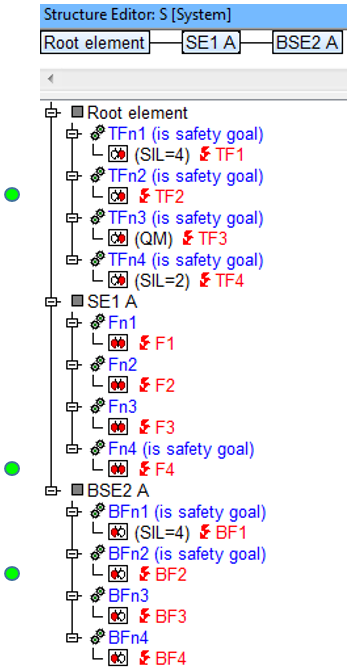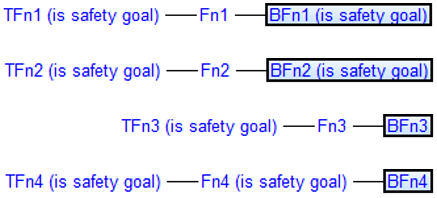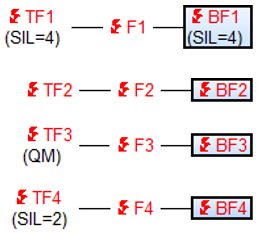Search:
Safety-critical failures without SIL
Explanation:
A search will be made for failures, which have no SIL classified but are anchored at functions assigned with safety goals.
This search will only deliver results if in the document settings “IEC 61508” is selected below “Functional Safety”
Example:
Abbreviations
- ASIL = Automotive safety integrity level
- BF = Base failure of a base function
- BFn = Base function of a base structure element
- BSE = Base structure element
- Cl Prc = Classification for process characteristic
- Cl Prd = Classification for product characteristic
- Cl Req = Classification for requirement
- CM = Control method
- DA = Detection action
- DC = Diagnostic coverage
- DSCF = Dangerous safety critical failure
- Er Det = Error detection
- Er Resp = Error response
- F = Failure
- FIT = Failure in time
- Fn = Function
- FSM = Functional safety management
- IE = Inspection equipment
- LF = Latent fault
- LFM = Latent fault metric
- OC = Operating condition
- PA = Preventive action
- PE = Process element
- PFH = Probability of failure per Hour
- PMHF = Probabilistic metric for random hardware failures
- PrcC = Process characteristic
- PrdC = Product characteristic
- QM = Quality method
- QR = Quality rule
- Req = Requirement
- RMR = Risk Matrix Ranking
- RP = Reaction plan
- SE = Structure element
- SE ErDet = Structure element for error detections
- SE ErResp = Structure element for error responses
- SFF = Safe failure fraction
- SG = Safety Goal
- SIL = Safety integrity level
- SM = Organisational-SE for “safety mechanisms”
- SPF = Single point fault
- SPFM = Single point fault metric
- TF = Top failure of a top function
- TFn = Top function at root element
- TS = Test sample

- In the above structure, it is possible to see which functions which are safety goals. You can also see which functions are assigned to which failures. With the correct Display options set, you can also see the SIL values. The base functions BFn1, BFn2, BFn3 and BFn4 are linked respectively to the functions Fn1, Fn2, Fn3 and Fn4 of which are in turn linked to the top functions TFn1, TFn2, TFn3 and TFn4. This can be seen more clearly in the following function graph links.

- In the same way, the base failures BF1, BF2, BF3 and BF4 are linked respectively to the failure effects F1, F2, F3 and F4 which in turn are linked to top failures TF1, TF2, TF3 and TF4. This can be seen clearly in the below failure net image.

- The aim of this Quality Rule is to find failures with no SIL assigned but are anchored at functions with safety goals. To set a safety goal to a function, you can use e.g. the properties dialog.
- There are seven functions in this example that have safety goals assigned. Not all of these though have failures with missing SIL values.
Search result: ![]()
TF2, F4 and BF2 are all hits as they fill the criteria of being IQ objects whereby the function has a safety goal and the failure has no SIL values assigned. TF3 is not a hit, because the QM value counts as a SIL value.


